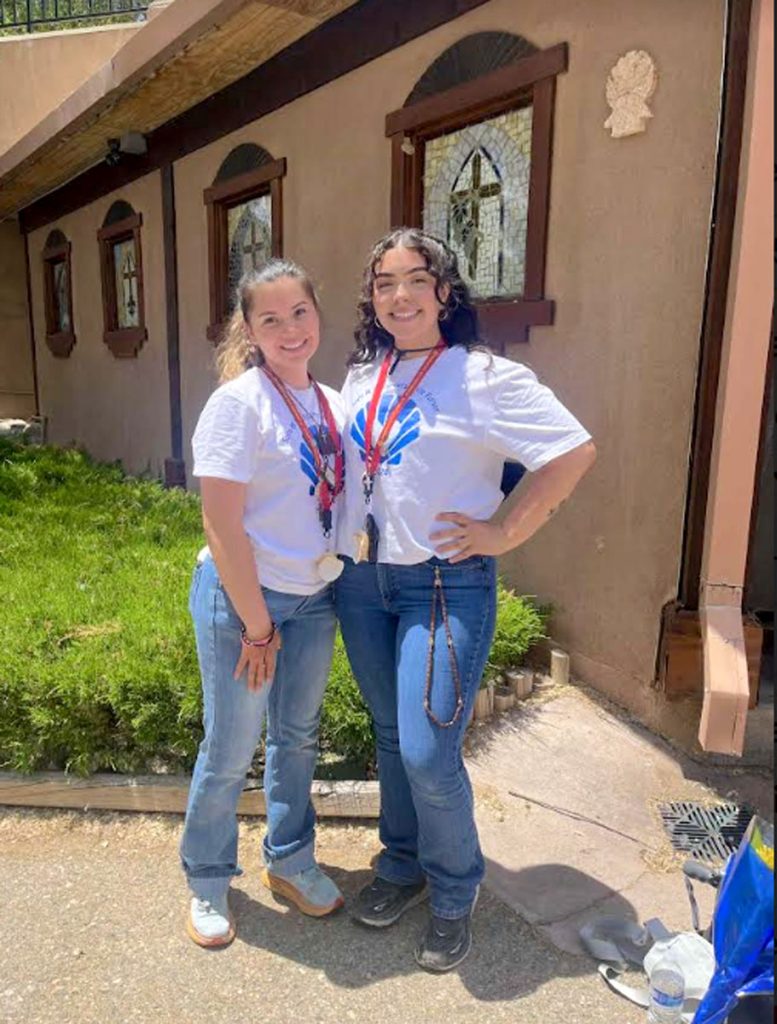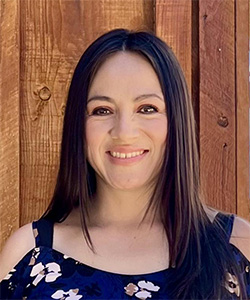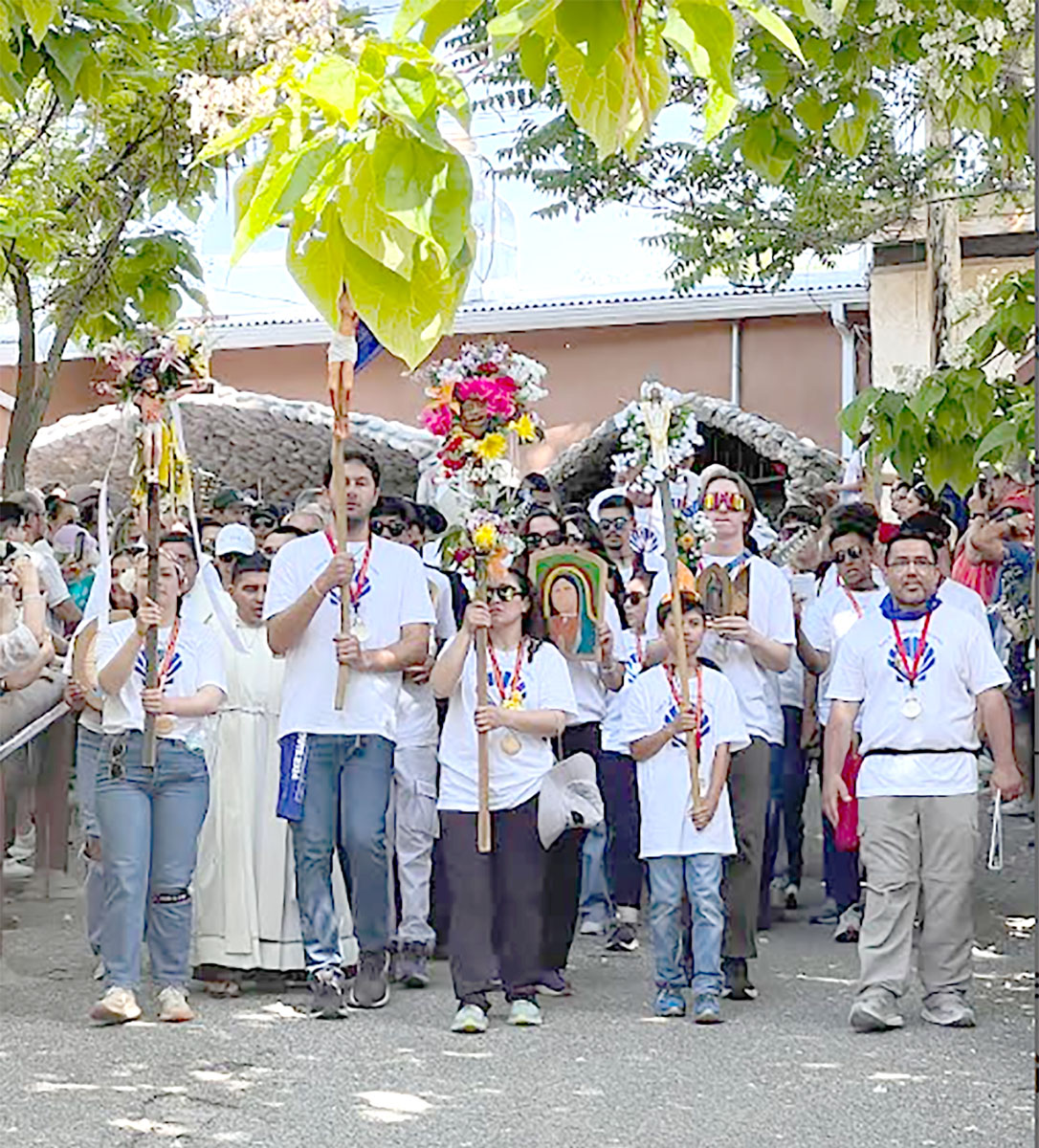
Walkers completing their 100-mile pilgrimage chanted “¡Que Viva Cristo Rey!” and in response, people respond with “iQue Viva!” These words echoed through the cottonwoods and willows surrounding the beautiful courtyard at the Santuario de Chimayo Catholic Church in Chimayo, New Mexico. The mature hardwoods gave just enough shade to those family members and friends anxiously awaiting the arrival of their loved ones who endured the 100-mile pilgrimage from various locations throughout New Mexico.
The 100-mile pilgrimage for vocations typically occurs the first week of June and has taken place since 1973. The walk was started by Father Michael O’Brien from the Archdiocese of Santa Fe, with the overarching goal of praying for vocations to increase the number of those called to the priesthood and religious life.
The men, referred to as Peregrinos, or pilgrims, are those who are traveling to a holy place. The women, called Guadalupanas, are those with a special devotion to Our Lady of Guadalupe, the Virgin Mary, and to St. Francis of Assisi.
The Peregrinos and Guadalupanas began their journey from four directions throughout New Mexico. From the north they start in Costilla. From the southwest, they begin in Estancia. From the east they begin in Bernal, and from the south, Albuquerque. The 200 walkers are divided into two male groups and two female groups. The theme this year was “Beloved Sons and Daughters of the Father.” Activities and scripture readings for the walkers were focused on this theme.
Walking is easy in small doses. We walk for exercise. We walk our pets. Many of us even track our steps. The average Fit Bit user walks between 3,000 to 4,000 steps in a day. Well, imagine walking approximately 40,000 steps in a day, walking along dirt roads and pavement, somewhat racing the sun before the heat beats you.
The goal for the walkers during the 100-mile pilgrimage is roughly 20 miles per day, starting during the early dawn hours on a Monday morning and culminating on Saturday before noon. After the daily mileage is achieved, walkers are able to nurse any injuries, nap, shower, and get some much needed rest. The Peregrinos and Guadalupanas endure hot temperatures, sore muscles, blisters, and overall strenuous physical conditions during the 100-mile pilgrimage for vocations.
Questa del Rio News interviewed sisters Larissa Passino and Kiana Huerta to understand what it’s like, walking through the pain and heat and why they continue to do it year after year. The sisters, originally from Questa, New Mexico, have walked 10 years combined, and have been encouraged to do so by family members as well as because of a deep connection to their faith.
Larissa Passino mentioned that she walks because she wants to get back in touch with herself and pray for things she’s been thinking about throughout the year. She also walks because many of her family members walk. Throughout the year, Passino keeps track of things she wants to pray for. One big reason why she keeps returning every year is because she wants to immerse herself back into her faith. She wants to be an inspiration to others, particularly young people, and help them get back to their Catholic faith if they’ve fallen away. This is the seventh year that Passino has walked, and her experience has varied. She reflects on how the first year was really tough but how it meant so much to her because her mom walked as well. The experience of walking involves lots of prayer, sometimes five to seven rosaries in a day, she says, along with lots of singing, and it’s a tough mental game. “You can be the strongest person, even do Iron Man, and this is still a tough thing to overcome. It’s 100 percent mental,” Passino says. Now a seasoned Guadalupana, the walk is easier both mentally and physically: “easier” being a relative term.
When asked how one overcomes the physical part of the walk, Passino humbly says, “compared to what Jesus Christ went through, I can get through this pain for a week.” What about missing school and work for a week, what was it like coordinating that, Questa del Rio News asked. “My professors and work supervisors were actually really supportive of me walking, but most don’t know what the walk was about. They’d asked in surprise, ‘how many miles are you walking?!’ When they found out what it was for, they supported me.
This year, Passino was a leader in her group of six. Smaller groups are broken out of the 42 women who were walking from the southern direction starting in Estancia. Her role this year was a “priest leader,” one who encouraged the group and individuals when they were struggling. “Some people walk through terrible blisters, sore muscles, and just being plain tired. I was able to support the women and help keep them going.” When asked what she would tell people if they were considering walking, she said, “I’d tell them, ‘Yes! Just do it! It’s so worth it and so fulfilling.’ “
Younger sister, Kiana Huerta walks for similar reasons. “I walk for vocations to the priesthood and religious life, for my personal intentions, to strengthen my faith, and for the sisterhood. I felt that this year I was able to help those who were having a hard time, help them carry their cross while carrying mine.” When asked about how her first year compared to her now third year walking, Huerta says that this year was actually her easiest walking experience. “My first year was tough,” she recalls “I had blisters, sore knees, and swollen feet. I didn’t think I’d make it.” There were moments where Huerta questioned what she was doing there and felt that she didn’t have the strength to finish the day. “You don’t know how much strength you actually have. It’s hard not to focus on the pain, and doubt kept creeping in, but in those moments, I’d offer my pain and suffering up to God and surrender myself.”
Huerta recalls walking from the north direction in 2023, where her experience included walking the many hills between Questa and Taos and feeling that she couldn’t make it. “It was the little miracles we take for granted, like a beautiful sunrise and seeing butterflies that reminded me of a loved one that had passed on… that helped me in the toughest moments.” Not to be overlooked are the many communities who serve the walkers breakfast, lunch, and dinner. Huerta talked fondly about those who fed them along the way. “Enchiladas, beans, rice, and dessert were one of my favorite dishes served this year because they reminded me of home. Our lemonade even had an umbrella in it.”
What would you say to someone who is considering walking? “I would tell them that the pilgrimage is a vacation with God, that you’ll strengthen your relationship with God, and to answer the call because it’s a beautiful experience.”
There were eight other walkers, all originally from Questa, who endured the 100 miles, and for many this was not their first time. The Peregrinos and Guadalupanas from northern New Mexico were: Miguel Rael, Matthew Rael, Isaac Ortega, Lynnae Rael, Jocelyne Ortega, Alyse Lovato, Kristen Torres, and Christian Arellano. Janice Cisneros participated as a trucker, making sure the walkers had what they needed—snacks, water, medical needs—and she also cautioned drivers. Truckers are usually the first to get up and the last to go to bed.
It’s very clear that the 100-mile walk will test your physical and mental capacity and that blisters and sore legs are part of the package. Even with the hardships the Peregrinos and Guadalupanas of New Mexico endure, the walk continues year after year. God willing, the sisters plan on continuing the tradition next year, and tucking another 100 miles under their belt.
Author
-

Experience working with the USDA Forest Service and extensive knowledge of the northern region, while maintaining and fostering strong community relationships remain a big priority.
View all posts


